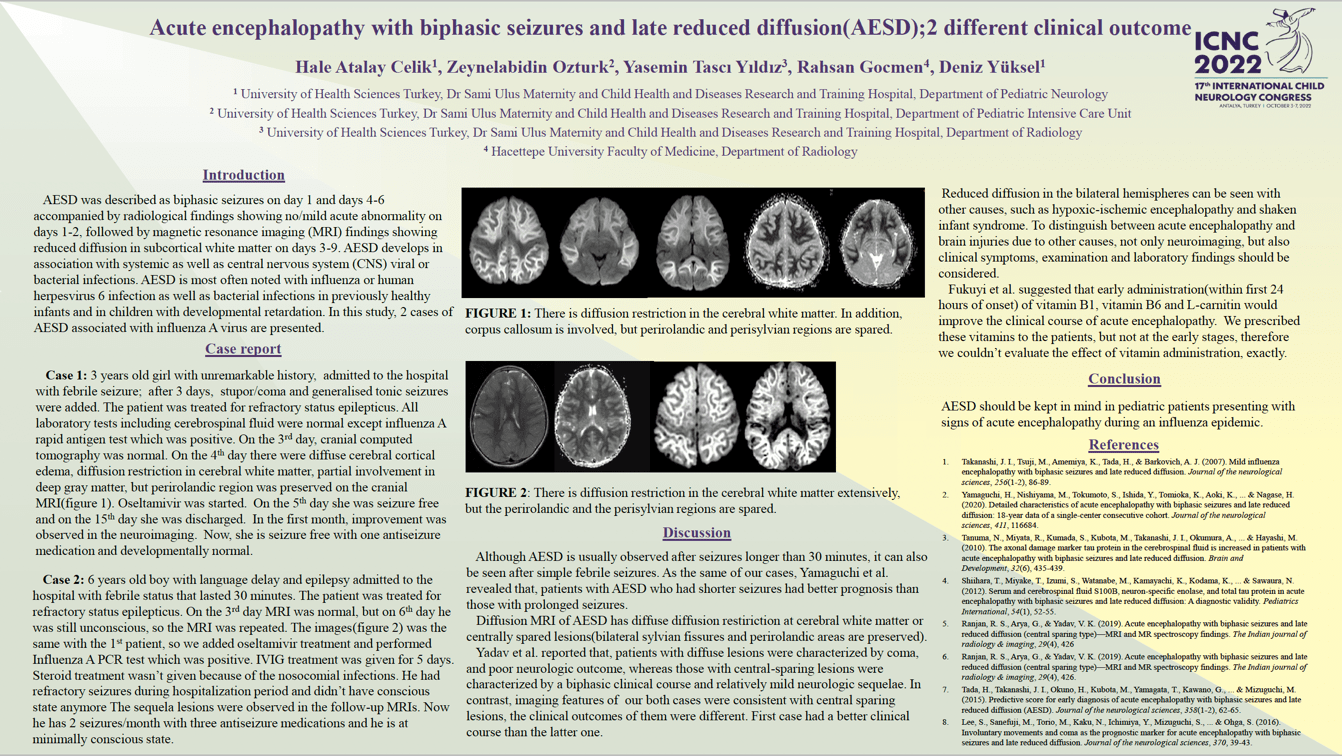Acute encephalopathy with biphasic seizures and late reduced diffusion (AESD); 2 different clinical outcome
Hale Atalay Celik, Zeynelabidin Ozturk, Yasemin Tascı Yıldız, Rahsan Gocmen, Deniz Yuksel
Introduction: AESD was described as biphasic seizures on day 1 and days 4-6 accompanied by radiological findings showing no/mild acute abnormality on days 1-2, followed by magnetic resonance imaging (MRI) findings showing reduced diffusion in subcortical white matter on days 3-9. AESD is most often noted with influenza or human herpesvirus 6 infection. Method: 2 cases of AESD associated with influenza A virus are presented. Results: Case1: 3 years old girl with unremarkable history, admitted to the hospital with febrile seizure; after 3 days, stupor/coma and generalised tonic seizures were added. The patient was treated for refractory status epilepticus. All laboratory tests were normal except influenza A rapid antigen test which was positive. On the 3rd day, cranial computed tomography was normal. On the 4th day there were cerebral cortical edema, reduced diffusion in white matter(Figure1). Oseltamivir was started. On the 4th day she was seizure free and fully recovered. Case2: 6 years old boy with epilepsy admitted to the hospital with febrile status that lasted 30 minutes. The patient was treated for refractory status epilepticus. On the 3rd day MRI was normal, but on 6th day MRI was the same with the 1st patient(Figure2), so we added oseltamivir treatment. Influenza A PCR was positive. IVIG treatment was given for 5 days. On the 15th day he was seizure free. Now he is at persistent vegetative state. Conclusion: AESD should be kept in mind in pediatric patients presenting with signs of acute encephalopathy during an influenza epidemic.
Keywords: acute encephalopathy, biphasic seizures, diffusion restriction, children
Hale Atalay Celik
University of Health Sciences Turkey, Dr Sami Ulus Maternity and Child Health and Diseases Research and Training Hospital
Turkey
Zeynelabidin Ozturk
University of Health Sciences Turkey, Dr Sami Ulus Maternity and Child Health and Diseases Research and Training Hospital
Turkey
Yasemin Tascı Yıldız
University of Health Sciences Turkey, Dr Sami Ulus Maternity and Child Health and Diseases Research and Training Hospital
Turkey
Rahsan Gocmen
Hacettepe University Faculty of Medicine
Turkey
Deniz Yuksel
University of Health Sciences Turkey, Dr Sami Ulus Maternity and Child Health and Diseases Research and Training Hospital
Turkey
Introduction: AESD was described as biphasic seizures on day 1 and days 4-6 accompanied by radiological findings showing no/mild acute abnormality on days 1-2, followed by magnetic resonance imaging (MRI) findings showing reduced diffusion in subcortical white matter on days 3-9. AESD is most often noted with influenza or human herpesvirus 6 infection. Method: 2 cases of AESD associated with influenza A virus are presented. Results: Case1: 3 years old girl with unremarkable history, admitted to the hospital with febrile seizure; after 3 days, stupor/coma and generalised tonic seizures were added. The patient was treated for refractory status epilepticus. All laboratory tests were normal except influenza A rapid antigen test which was positive. On the 3rd day, cranial computed tomography was normal. On the 4th day there were cerebral cortical edema, reduced diffusion in white matter(Figure1). Oseltamivir was started. On the 4th day she was seizure free and fully recovered. Case2: 6 years old boy with epilepsy admitted to the hospital with febrile status that lasted 30 minutes. The patient was treated for refractory status epilepticus. On the 3rd day MRI was normal, but on 6th day MRI was the same with the 1st patient(Figure2), so we added oseltamivir treatment. Influenza A PCR was positive. IVIG treatment was given for 5 days. On the 15th day he was seizure free. Now he is at persistent vegetative state. Conclusion: AESD should be kept in mind in pediatric patients presenting with signs of acute encephalopathy during an influenza epidemic.
Keywords: acute encephalopathy, biphasic seizures, diffusion restriction, children
Hale Atalay Celik
University of Health Sciences Turkey, Dr Sami Ulus Maternity and Child Health and Diseases Research and Training Hospital
Turkey
Zeynelabidin Ozturk
University of Health Sciences Turkey, Dr Sami Ulus Maternity and Child Health and Diseases Research and Training Hospital
Turkey
Yasemin Tascı Yıldız
University of Health Sciences Turkey, Dr Sami Ulus Maternity and Child Health and Diseases Research and Training Hospital
Turkey
Rahsan Gocmen
Hacettepe University Faculty of Medicine
Turkey
Deniz Yuksel
University of Health Sciences Turkey, Dr Sami Ulus Maternity and Child Health and Diseases Research and Training Hospital
Turkey

Hale Atalay Celik
University of Health Sciences Turkey, Dr Sami Ulus Maternity and Child Health and Diseases Research and Training Hospital Turkey
University of Health Sciences Turkey, Dr Sami Ulus Maternity and Child Health and Diseases Research and Training Hospital Turkey